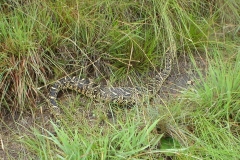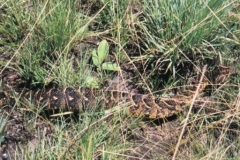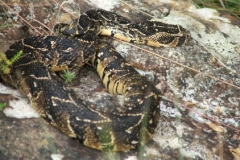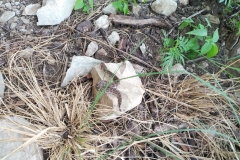Length: 60 – 90 cm average; 120 cm maximum
Description:
In the Natal Drakensberg the puff adder is generally brightly coloured, either black / dark grey and bright yellow, or black / dark grey and deep orange, with the lighter colours appearing in backward-pointing chevrons along its full length. In other words, the open ends of each chevron point towards the toothy end of the snake! The proportions of the two colours appear to vary, perhaps with age. It enjoys sunning itself on open paths and exposed rock, where it is most likely to be encountered.
The puff adder is a fat snake with a huge, triangular head and prominent cheeks containing two long, curved fangs which are hinged at the front of the mouth. The rear third of the body tends to be the broadest – about the thickness of a man’s forearm for a snake of about 1 metre in length. This considerable bulk results in the puff adder being very slow, and since it is usually not fast enough to make a getaway, it will tend to coil and adopt a defensive posture, ready to strike at anything that moves within its range. This initial movement is what may warn a hiker of its presence, and may be accompanied by intense and furious huffing which is sure to grab your undivided attention! What it lacks in speed of locomotion it makes up for in the strike, since it is one of the fastest striking snakes at about 1/27 of a second! Because of its weight, this snake is quite capable of penetrating synthetic shoes and even thin leather with its long fangs. Its movement is similar to that of a python, since it propels itself mainly by “walking” on its ribs rather than slithering. If it does attempt to put on any speed, this is usually achieved by a sidewinder-like movement.
Biology:
Frogs and rodents – both numerous in the Drakensberg – form its main diet. On average 20 to 40 live young are produced per brood.
Poisoning Symptoms:
The poison is virulently cytotoxic (cell-destroying), but slow acting. The bite is followed by immediate and severe pain, accompanied by alarmingly rapid swelling and bruising at the bite site. Life-endangering effects such as pronounced shock do not normally appear until 12 to 24 hours after the bite. Extensive cell damage can result in gangrene and may require the amputation of the affected limb if medical attention is not received soon enough.
Treatment:
Treat as an extreme emergency. Calm and immobilise the victim. Use a suction kit if you have one (the Aspivenin kit is highly recommended and can also be used for insect stings). DO NOT APPLY A PRESSURE BANDAGE! Do not use vasopressors (drugs which increase the blood pressure) because these will increase swelling at the bite site. Contact a Poison Information Centre and hospitalise the victim as soon as possible.
Remarks:
In 2003 a hiker was bitten on her ankle by a puff adder just 1 hour from the end of the hike. The group decided that it would take longer to send for help than it would for her to continue walking back to their starting point – at least by sending a runner ahead, by the time she got there herself other arrangements would be in place to evacuate her to hospital immediately. In any case, over such a short period of time it was felt that her activity would have little impact on the localised effects of the cytotoxic poison. This decision still seems perfectly logical. Although she was admitted to hospital within 3 hours, she gained more than 20 kg in body fluids and took nearly 3 months to make a full recovery. Controversy still surrounds whether this increase in body fluids was caused by the spread of the poison, medically administered cortisone – or both. She apparently received a heavy dose of poison because the puff adder hung from her leg as she tried to run away from it.
Recent research on puff adder venom in South Africa (*citation needed) suggests that keeping the victim active may actually decrease the venom’s effect by allowing it to spread through the lymphatic system instead of remaining more localised. The argument is that since the poison is cytotoxic, it will damage cells far faster in high concentration and lead to pronounced shock sooner. The recommendation is to relieve the victim of his / her backpack to reduce the effort required, walk out of the Berg, and get to a hospital as soon as possible. Depending on where the bite site is, walking may be difficult and very painful, so progress may be quite slow.




